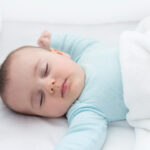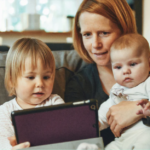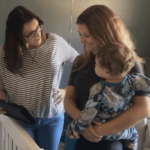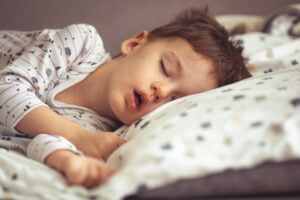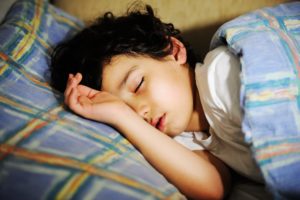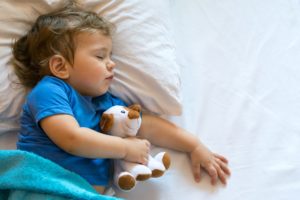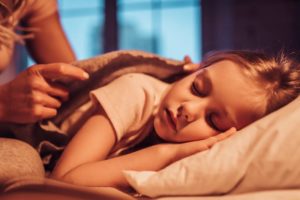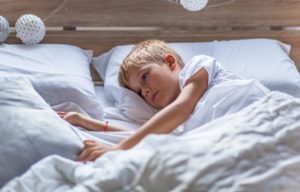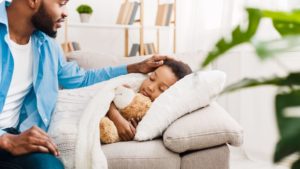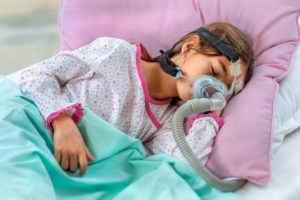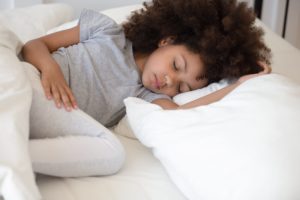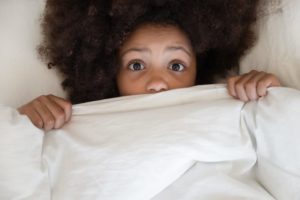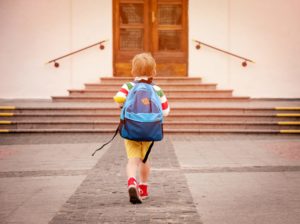When you buy through our links, we may earn a commission. Products or services may be offered by an affiliated entity. Learn more.
How To Dress Your Child for Sleep
As your child grows, you may wonder what is appropriate sleepwear for babies, toddlers, and school-aged children. It can be tricky to find pajamas that tick all the boxes for comfort, safety, and convenience. This article highlights how to choose the best sleepwear for babies and children so your little ones can sleep soundly.
How to Dress Your Baby for Sleep
As a guideline, you should dress your baby in one more layer than what an adult would find comfortable. The American Academy of Pediatrics (AAP) recommends that babies sleep without a blanket to reduce the risk of Sudden Infant Death Syndrome (SIDS), but there’s no need to overbundle.
On a warm night, you can dress your baby in breathable cotton pajamas, a onesie, or even just a diaper coupled with a lightweight swaddle. On a cooler night, try layering a long-sleeved onesie or footed pajamas with a swaddle or sleep sack over top.
Baby sleepwear that snaps or zips open in the front or on both legs can facilitate diaper changing, but avoid strings, badly placed fasteners, and other elements that pose a risk to your baby. Ideally, the sleeping outfit should be loose and stretchy enough to put on easily, but not so loose that it rides up around your baby’s face or neck. Favor natural materials that won’t irritate your baby’s skin, and choose well-fitting clothing in good condition.
Help Your Child Sleep Better With Pediatric Sleep Coaching
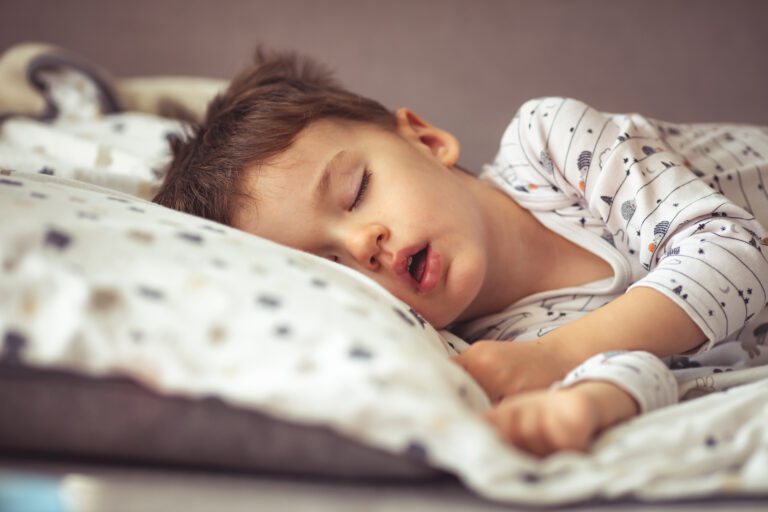
our partner at sleepdoctor.com
Learn More“Life-changing! My anxiety about my son’s sleeping habits were immediately reduced after talking to Sara. She went above and beyond to tailor a schedule to our goals, answer our questions, keep us on track, and check in to encourage us when we just thought we couldn’t do it anymore.”
Rachael B. – Verified Customer
What’s the Difference Between a Sleep Sack and a Swaddle?
A swaddle wraps your baby up like a burrito, whereas a sleep sack (or wearable blanket) is slightly looser and leaves the arms free.
A swaddle can make your newborn feel more secure. It also limits the startle response, helping them sleep more soundly. However, it can also pose a risk because it constricts a child’s movement. If babies roll over onto their stomach while in a swaddle, they may get trapped in that position and be at a higher risk for SIDS . This is why you should always place a swaddled baby firmly on their back for sleep.
If you do choose to swaddle a newborn , be sure to leave enough wiggle room to let their hips develop properly. You should also leave a two- to three-finger gap between the swaddle and their chest so they can breathe easily.
Since most babies learn to roll over around the three-month mark, it’s best to eliminate the swaddle around the two-month mark or as soon as your baby starts to roll in either direction. At this point the AAP suggests using a sleeveless wearable blanket, also known as a sleep sack, to keep the baby warm while leaving the hands free to assist in rolling. This helps prevent your baby from getting trapped on their stomach.
Should I Worry About My Baby Being Cold?
To reduce the risk of SIDS it’s better for your baby to be on the cooler side, rather than too hot. Premature babies may have more trouble keeping warm, so it is appropriate to dress them a little more warmly. By contrast, when your baby has a fever , resist the urge to turn up the heat or add extra clothes.
Avoid using hats or anything else that covers the baby’s face or head, as your baby regulates temperature by releasing heat through the head. You can monitor for overheating by touching your baby’s chest or checking for telltale signs such as sweating, flushed cheeks, damp hair, a heat rash, or rapid breathing. Don’t worry if the hands and feet feel colder than the rest of the body.
The AAP does not provide an exact temperature range for the bedroom, but it’s best not to keep the room too hot. If you use a fan, adjust it so that the air doesn’t blow straight at your infant.
What Should a Toddler Wear to Bed?
When choosing pajamas for your toddler, opt for soft, breathable, chemical-free fabrics such as cotton. Avoid fleece and other synthetic fabrics that don’t breathe as well. If it’s cold, you can add socks, a onesie, or use footed pajamas. While you want pajamas to fit snugly, they shouldn’t overly restrict movement. Toddlers may have fun picking out their favorite pajamas for the night, so feel free to incorporate this into their bedtime routine.
Most toddlers start using their own blanket between the ages of one and two. Nevertheless, toddlers have a habit of kicking off their blankets, so be sure to dress them accordingly. If you have trouble getting them to keep the covers on, many companies also make sleep sacks for toddlers.
The law requires children’s sleepwear to be either flame-retardant or tight-fitting so it doesn’t pose a fire hazard . You may want to check the tag to ensure the pajamas don’t contain chemical flame retardants. It’s also a good idea to watch out for loose ties, broken zippers, or other choking and strangulation hazards.

Still have questions? Ask our community!
Join our Sleep Care Community — a trusted hub of sleep health professionals, product specialists, and people just like you. Whether you need expert sleep advice for your insomnia or you’re searching for the perfect mattress, we’ve got you covered. Get personalized guidance from the experts who know sleep best.
References
7 Sources
-
TASK FORCE ON SUDDEN INFANT DEATH SYNDROME (2016). SIDS and other sleep-related infant deaths: Updated 2016 recommendations for a safe infant sleeping environment. Pediatrics, 138(5), e20162938.
https://pubmed.ncbi.nlm.nih.gov/27940804/ -
American Academy of Pediatrics. (2016, June 17). Tips for Dressing Your Baby. HealthyChildren.Org., Retrieved January 5, 2021, from
https://www.healthychildren.org/English/ages-stages/baby/diapers-clothing/Pages/Dressing-Your-Newborn.aspx -
McDonnell, E., & Moon, R. Y. (2014). Infant deaths and injuries associated with wearable blankets, swaddle wraps, and swaddling. The Journal of pediatrics, 164(5), 1152–1156.
https://pubmed.ncbi.nlm.nih.gov/24507866/ -
American Academy of Pediatrics. (2020, August 17). Swaddling: Is it Safe? HealthyChildren.Org., Retrieved January 5, 2021, from
https://www.healthychildren.org/English/ages-stages/baby/diapers-clothing/Pages/Swaddling-Is-it-Safe.aspx -
A.D.A.M. Medical Encyclopedia. (2022, February 4). When your baby or infant has a fever. MedlinePlus., Retrieved January 5, 2021, from
https://medlineplus.gov/ency/patientinstructions/000319.htm -
Ben-Joseph, E.P. (2019, June). Sleep and Your 1- to 2-Year-Old (for Parents) – Nemours KidsHealth., Retrieved January 5, 2021, from
https://kidshealth.org/en/parents/sleep12yr.html -
United States Consumer Product Safety Commission. (n.d.). Children’s Sleepwear Regulations. CPSC.Gov., Retrieved January 5, 2021, from
https://www.cpsc.gov/Business--Manufacturing/Business-Education/Business-Guidance/Childrens-Sleepwear-Regulations


